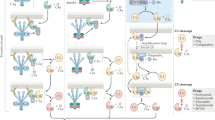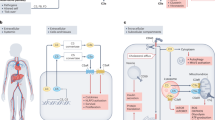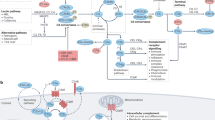Abstract
THE recent clinical use of the nitrogen mustards for the treatment of Hodgkin‘s and other neoplastic diseases1 has focused attention on these compounds and more particularly on their biological action. The intensive study of these vesicants made during the War2, when they were regarded as potential chemical warfare agents, has been continued in the hope that more information will be gained about their action on animal tissues and about the basis of their therapeutic effect.
This is a preview of subscription content, access via your institution
Access options
Subscribe to this journal
Receive 51 print issues and online access
$199.00 per year
only $3.90 per issue
Buy this article
- Purchase on Springer Link
- Instant access to full article PDF
Prices may be subject to local taxes which are calculated during checkout
Similar content being viewed by others
References
Gilman, A., and Philips, F. S., Science, 103, 409 (1946). Rhoads, C. P., J. Amer. Med. Assoc., 131, 656 (1946). Goodman, L. S., Wintrobe, M. M., Dameshek, W., Goodman, M. J., Gilman, A., and McLennan, M. T., ibid., 132, 126 (1946). Jacobson, L. O., Spurr, C. L., Barren, E. S. G., Smith, T. R., Lushbaugh, C., and Dick, G. F., ibid., 132, 263 (1946). ApThomas, M. I. R., and Cullumbine, H., Lancet, 252, 899 (1947). Wilkinson, J. F., and Fletcher, F., ibid., 253, 540 (1947).
This was the subject of secret reports during the War, but much of it has since been published in scientific journals: cf. among others, Cameron, G. R., Courtice, F. C., and Jones, R. P., J. Path. Bact., 59, 425 (1947), and references (4), (5) and (6). Some of the war work was briefly reported at a symposium of the Biochemical Society (cf. report by Boyland, E., Nature, 161, 225 (1948)).
Boursnell, J. C., Francis, G. E., and Wormall, A., Biochem. J., 40, 774 (1946).
Hanby, W. E., and Rydon, H. N., J. Chem. Soc., 513 (1947).
Hanby, W. E., Hartley, G. S., Powell, E. O., and Rydon, H. N., J. Chem. Soc., 519 (1947). Cf. also Golumbic, C., Fruton, J. S., and Bergmann, M., J. Org. Chem., 11, 518 (1946), cited from Chem. Abstr., 41, 692 (1947).
Boyland, E., Brit. J. Pharmacol, 1, 247 (1946).
Author information
Authors and Affiliations
Rights and permissions
About this article
Cite this article
WATKINS, W., WORMALL, A. Inactivation of Complement by Nitrogen Mustard. Nature 162, 535–536 (1948). https://doi.org/10.1038/162535a0
Issue Date:
DOI: https://doi.org/10.1038/162535a0
This article is cited by
Comments
By submitting a comment you agree to abide by our Terms and Community Guidelines. If you find something abusive or that does not comply with our terms or guidelines please flag it as inappropriate.



